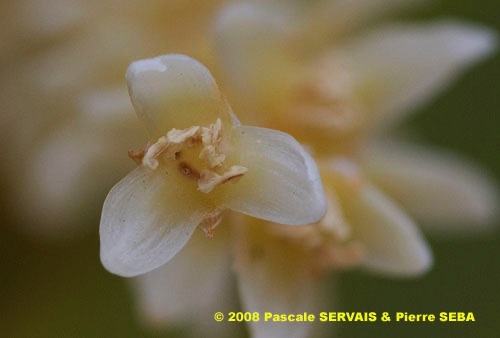
Phoenix canariensis hort. ex Chabaud
Fam. : Arecaceae
© Pascale SERVAIS & Pierre SEBA, 2018. Tilo Botanica: Flore de Tilos et du Dodécanèse / Flora of Tilos and of the Dodecanese
English translation by Brenda Bradbury, Howard Bradbury and Stéphane Léonard
Arbre dioïque, à tronc solitaire marqué par les cicatrices losangiques des feuilles tombées, très souvent planté pour l’ornement.
Feuilles en couronne au sommet du tronc, composées imparipennées, glabres, vertes, de 5 à 6 m de long, obliques (se tordant pour devenir verticales), à folioles de 40 à 50 cm dans le milieu, étroites, rigides et disposées de manière irrégulière sur le rachis.
Fleurs à symétrie radiaire, unisexuées, crème à jaunâtres, réunies en inflorescences interfoliaires très ramifiées et entourées d’une spathe quand elles sont jeunes. Inflorescences courtes chez les spécimens mâles et longues chez les spécimens femelles. 3 pétales et 3 sépales. 6 étamines.
Fruits, baies de 15 à 23 mm de long, oblongues, orangé à rouge brun foncé, charnues mais non comestibles, à une seule graine.
___________________________
Tree dioecious, with a solitary trunk marked with the diamond-shaped scars of the fallen leaves, very often planted for ornament.
Leaves in the shape of a crown at the top of the trunk, compound imparipinnate, glabrous, green, from 5 to 6 m long, oblique (twisting to become vertical), with leaflets from 40 to 50 cm in the centre, narrow, rigid and irregularly laid out on the midrib.
Flowers radially symmetrical, unisexual, cream-coloured to yellowish, joined together in interfoliaceous very branched inflorescences and surrounded by a spathe when youthful. Inflorescences short on the male specimens and long on the female specimens. 3 petals and 3 sepals. 6 stamens.
Fruits, berries from 15 to 23 mm long, oblong, orange to dark brown red, fleshy but nonedible, with only one seed.
Descripteurs / Identifying features
1
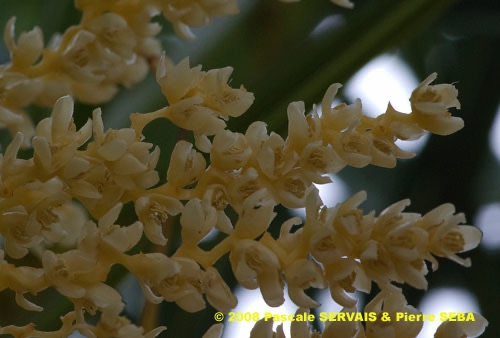
2
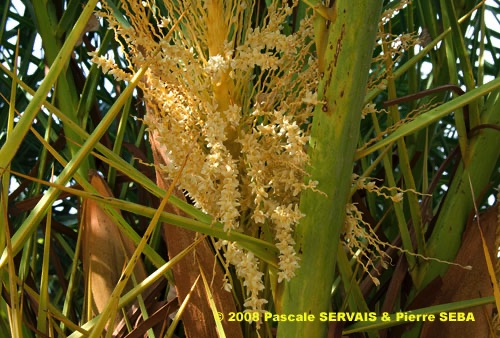
3
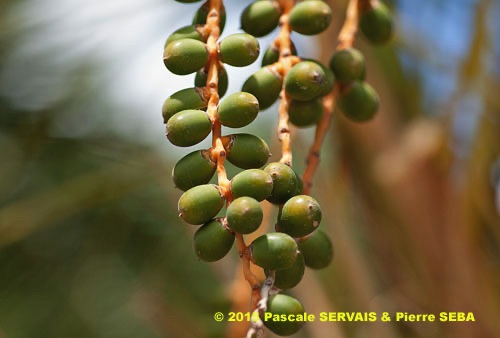
4
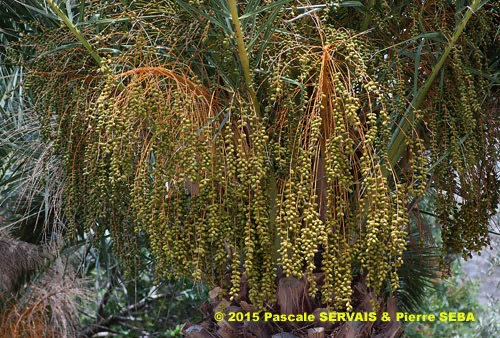
5
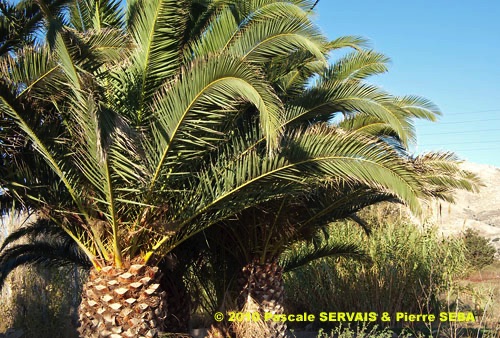
6
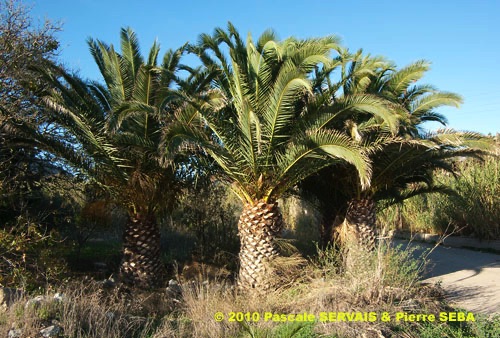
7
Étymologie / Etymology :
Phoenix : emprunt du latin phoenix, -icis (nom) = le palmier, nom donné
à la plante par Pline, naturaliste latin mort en 79 apr. J.-C., forme
latinisée du grec ancien φοῖνιξ, -ικος (nom) = le palmier.
Canariensis : emprunt du latin médiéval canariensis, -is, -e (adj.)
= des îles Canaries, qui vient des îles Canaries.
Phoenix : borrowed from Latin phoenix, -icis (noun) = palm, name given
to the plant by Plinius, Latin naturalist died in 79 AD, Latinized form
of the Classical Greek φοῖνιξ, -ικος (noun) = palm.
Canariensis : borrowed from medieval Latin canariensis, -is, -e (adj)
= of or from Canary islands, which comes from Canary islands.
Synonymes / Synonyms :
Phoenix jubae Webb ex Christ
Phoenix vigieri Naudin
Noms vernaculaires / Common names :
Noms français / French names :
Dattier des Canaries — Faux dattier — Palmier des Canaries.
Noms grecs / Greek names :
Φοίνιξ κανάριος — Φοίνιξ ο κανάριος.
Noms anglais / English names :
Canary date — Canary date palm — Canary island date-palm —
Canary palm.
Noms allemands / German names :
Dattelpalme — Kanarische Dattelpalme — Kanarische Palme.
Noms espagnols / Spanish names :
Palma canaria — Palma de jardín — Palmera canaria —
Palmera de Canarias.
Nom italien / Italian name :
Palma delle Canarie.
Habitat :
Jardins.
Gardens.
Île / Island :
Tilos.
Hauteur / Height range :
De 10 m à plus de 15 m.
From 10 m to 15 m and more.
Floraison / Flowering time :
De septembre à mars.
From September to March.
Groupe / Classification :
Monocotylédones.
Monocotyledons.
Pérennité / Lifespan :
Vivace.
Perennial.
Description :
Photo 1 :
Localisation / Location : Tilos, Megalochorio, Erystos
Date : 26/09/2008
GPS : Lat. 36,43462° N / Long. 27,34787° E / Alt. 12 m
Type : Photographie numérique / Digital Photograph (10 mégapixels)
Photo 2 :
Localisation / Location : Tilos, Megalochorio, Erystos
Date : 26/09/2008
GPS : Lat. 36,43462° N / Long. 27,34787° E / Alt. 12 m
Type : Photographie numérique / Digital Photograph (10 mégapixels)
Photo 3 :
Localisation / Location : Tilos, Megalochorio, Erystos
Date : 26/09/2008
GPS : Lat. 36,43462° N / Long. 27,34787° E / Alt. 12 m
Type : Photographie numérique / Digital Photograph (10 mégapixels)
Photo 4 :
Localisation / Location : Tilos, Megalochorio, Erystos
Date : 25/05/2015
GPS : Lat. 36,43463° N / Long. 27,34788° E / Alt. 12 m
Type : Photographie numérique / Digital Photograph (10 mégapixels)
Photo 5 :
Localisation / Location : Tilos, Megalochorio, Erystos
Date : 25/05/2015
GPS : Lat. 36,43463° N / Long. 27,34788° E / Alt. 12 m
Type : Photographie numérique / Digital Photograph (10 mégapixels)
Photo 6 :
Localisation / Location : Tilos, Megalochorio, Erystos
Date : 21/11/2010
GPS : Lat. 36,43463° N / Long. 27,34788° E / Alt. 12 m
Type : Photographie numérique / Digital Photograph (10 mégapixels)
Photo 7 :
Localisation / Location : Tilos, Megalochorio, Erystos
Date : 21/11/2010
GPS : Lat. 36,43463° N / Long. 27,34788° E / Alt. 12 m
Type : Photographie numérique / Digital Photograph (10 mégapixels)

Google Maps
Google Maps
Google Maps
Google Maps
Google Maps
Google Maps
Google Maps